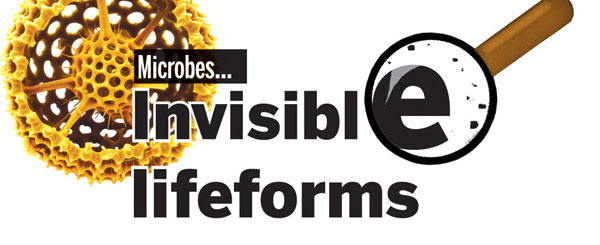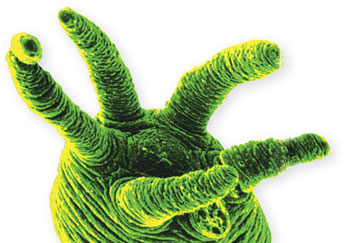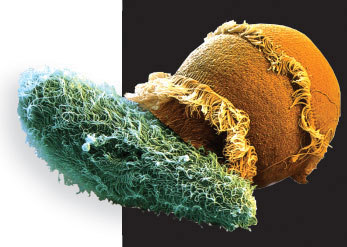|

They look weird, are dangerous and sometimes even deadly, and they
are everywhere! Millions no, trillions of them may be swimming in the
waterways, flying through the air or crawling on the ground, even all
over our bodies (inside too) at this very moment, but we do not see
them. Why? Because they are tiny specks of life that belong to the
invisible microscopic world.
These microscopic lifeforms are tinier than the full stop you see
here, so, even with perfect eyesight human beings cannot see them with
their naked eyes. Algae, bacteria, viruses, fungi, protists all belong
to the world of microbes.
|

Hydra lives in freshwater |
You will be amazed to learn that these weird-looking microscopic
lifeforms have been around for much longer than we humans have and
outnumber us by at least a trillion, trillion trillion times!
They are everywhere, from snowy mountains to the ocean floor and even
deep down inside the Earth. And what's fascinating is that they have
been there always and we only started to 'see' these invisible creatures
and began to really take notice of them after the invention of the
microscope.
In fact even the names by which these microscopic lifeforms are
identified sound strange because they are only seen by scientists who
conduct research into the microworld. When people initially started to
explore the micro world using microscopes about 400 years ago, they had
been not only amazed but also horrified to discover that Earth was
teeming with tiny, weird-looking living creatures. And so these
lifeforms which we had ignored all this time came into the limelight
because some of them have the power to make us very sick and even kill
us.
Microlife plays a dual role in our lives; they could be our enemies
or our friends. Just as much as microscopic lifeforms could snuff the
life out of us, they could also help us survive on this Earth.
Let's step into the microworld today to at least learn about a few of
these invisible creatures. The deeper you go down into it, the smaller
the creatures become. The lifeforms differ from one level to the other.
The microworld is indeed a bewildering place when it comes to size and
form, with some of the lifeforms not even being classed as animals and
taking alien forms.
For instance, Hydra is an alien looking life form that lives in ponds
and waterways attached to aquatic vegetation. They are the freshwater
relatives of corals, sea anemones and jellyfish.
Hydra live in freshwater and spend their entire lives attached to
plants. Each one has a ring of tentacles at the end of a slender stalk.
They use these tentacles to catch food. Would you believe that this
micro organism Hydra grows a tiny bud which becomes a baby, when it
feels like becoming a parent? The tiny baby which is stuck firmly to its
parent's side shares its stomach, so it has no problem getting food.
However, once it is a few days old, it unfastens itself and creeps
away, from the parent. Even though a Hydra's baby manages to do so, the
baby of a Volvox, another micro-plant that lives in murky water makes
sure its offspring does not escape.
The Volvox may appear as just a small, uninteresting blob to our
naked eyes, but under a microscope, it is revealed as a beautiful bubble
of bright green cells. The bubble which is made of a kind of jelly has a
hollow in its centre and this is where the baby Volvox is kept - out of
harm's way. Volvox swim using tiny hairs which they beat like wings or
hands. As each adult can have more than one baby, there are several
young rumbling inside of them as they go about. Even the young Volvox
can produce babies inside their own bodies, and so one Volvox can end up
creating a collection of micro-plants that roll around inside the parent
Volvox.
Then there are simple organisms which are neither true animal nor
true plant, consisting of just a single cell which are called protists.
Even though a few of the protists.
Even though a few of the protist are big enough to be visible to the
naked eye, the majority are micro-organisms. Didinium is a predatory
protist. These free-living carnivores are found mostly in fresh and
brackish water environments. Three marine species are also known.
Most micro swimmers move through the water by waving their hairs
around. Protists such as Giardia and Euglena have long hairs called
flagella. Others, such as Paramecium have short hairs called cilia.
Infact, Paramecium has a 'fur coat' of cilia which it uses like oars to
move about in ponds and puddles searching for food. This micro hunter
which is a tough bacterium moves at one sixth the speed of a snail and
yet, it could win a medal at an Microlife Olympics for speed!
Giardia is a protist that swims by beating a set of eight hairs.
Guess where it swims? Inside our intestines. It is a parasite that can
cause many diseases.
Radiolarians are amoeboid protoza with amazing glass-like
exoskeletons. These microscopic predators which are marine organisms are
smaller than a speck of dust. Their skeletons are amazing structures.
Tardigrades which are also called water bears are tiny animals
between o.1 mm and 1.5 mm. They are multicellular invertebrates found in
different environments around the world - from the polar regions to the
equator. These micro animals have eight short legs that end in claws.
Their favourite food is lichens but according to scientists these tiny
creatures can live without food or water for years. They are also
capable of withstanding temperatures ranging from - 270 degrees Celsius
to + 150 degrees Celsius.
Tardigrades are also able to stop their metabolism and become
immortal (state cryptobiosis). In order to enter this state, tardigrades
retract their legs and become virtually dehydrated. They lose over 99
per cent of the water in their bodies and replace it with a sugar they
synthesize. It's a kind of anti-freeze that protects its cells. During
this period it limits further water loss and protects itself in a small
ball of wax called a microscopic barrel. It comes back to life when
favourable conditions return.
Scientists have managed to keep a tardigrade for eight years in a
state of cryptobiosis. It is believed that these creatures can stay in
this state for thousands of years because tardigrades found in an ice
sheet 2,000 years ago had comeback to life.
Have you ever wondered about the green dust that gets on your clothes
or body when you climb a tree or play in puddles of water with the water
in a pond? They are tiny algae, plant-like life forms that live by
gathering the energy in light.
Chlorella is one such tiny algae which measures about 0.015 mm
(0.0006 in) across. They are so tiny that it would take about 70
Chlorella to stretch across a fullstop.
Microlife is most abundant and diverse in the sea. While some
organisms live on the ocean floor, many spend all their lives floating.
Ceratium is a plank tonic algae or micro plant which is only 0.5 mm
long. When magnified it appears like a spiky helmet. It is said that the
Ceratium moves by beating two microscopic hairs called flagella, set at
right angels to each other.
Among the micro-plant predators, the radiolarians are considered
dangerous. Even though just a few millimetres across, they are
surrounded by invisible threads and spikes. They trap anything edible
that they touch and mop up millions of tonnes of algae each year.
Well, the world of microbes is full of bewildering creatures and
there are many more creatures that we like to introduce to you,
especially the dust mites and various bacteria. So, look out for facts
on more of these microscopic lifeforms next week.
Facts and Pix: Internet and Microlife
(All pictures are magnified)
Take an elevator ride into the micro world

If you imagine yourself on an elevator ride going down about 9 floors
into the microworld, here's what you'll find at different levels....
Level 1 - Water fleas, Hydra and a host of such creatures all not
more than 1 mm long live here.
Level 2 - Land of single cells or protist such as Didinium and
Paramecium.
Level 3 - Tiny algae such as Chlorella with complex cells like the
ones, we humans have in our bodies.
Level 4 - Bacteria or if you prefer, you can call it the world of
bugs and germs. Definitely not a place to hang around.
Level 5 - The smallest bacteria - the Mycoplasmas are found at this
level. These micro-microbes are said to be the smallest things made up
of cells. At just 0.0002 mm across the Mycoplasmas are believed to be
the smallest things on Earth to be alive.
|

Dininium(right) attacking another protist. |
Level 6 - It's the virus territory - so watch out. Viruses are like
tiny packages of chemicals that come alive when they invade liv ing
cells. In fact, as viruses can not live without entering or invading
living cells, they hardly qualify to be classed among the other
microscopic lifeforms you have met at the other lev els so far. There
are different types of viruses and the large ones may be as long as
Mycoplasmas, but most of them are only 0.000017 mm across. Viruses are
smaller than even waves of light. They do not have any colour of their
own. If you see photographs of viruses note that the colours have been
added only after the actual picture has been taken.
Level 7 - By this time, it is really difficult to view anything -
even the most powerful light microscopes which can magnify objects up to
2000 times (that were used to inspect the Mycoplasma) or the beams of
electrons and X-rays used on Level 6 will not show any lifeforms here.
In fact, everything at this level is million times smaller than at Level
1 and simply cannot have even a flicker of life. So what we get here are
individual chemicals - Macromolecules that are complicated substances
such as DNA which contains all the chemical instructions needed to make
living things.
Level 8 - No more microbes here. Just simple chemicals like glucose
which has only 24 atoms.
Level 9 - The last floor is filled with individual atoms. They are
the smallest complete pieces of matter inside living things. |

